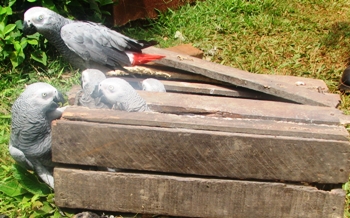 African grey parrots: Now endangered by notorious capturers Two "notorious" parrot capturers, Roger Atangana and Ignace Onana were recently arrested and detained pending trial, for illegally trapping African Grey Parrots.
African grey parrots: Now endangered by notorious capturers Two "notorious" parrot capturers, Roger Atangana and Ignace Onana were recently arrested and detained pending trial, for illegally trapping African Grey Parrots.
The duo is responsible for the capture of over 5,000 parrots each year in Lobeke National Park and its buffer zone, in the East Province.Their arrests were orchestrated by local forest and wildlife authorities in Boumba et Ngoko Division, in collaboration with the gendarmerie, facilitated by WWF.
Atangana was arrested in his house in Kika, a logging town, southeast of Lobeke after a scuffle with gendarmes and game rangers resulted in him being shot in the arm. On his part, Onana was arrested while attempting to capture parrots in Djangui, a forest clearing inside Lobeke.
Atangana and Onana have been operating in complicity for over 10 years. So far this year they are suspected to have slaughtered some 1000 parrots, according to wildlife authorities. Both recidivists, Atangana succeeded in escaping from the firm grip of game rangers last year after he was arrested with 167 beheaded parrots near Lobeke.
However, he was recently helmed in when a hand grenade was discovered in his home in March.The two men had also devised a new method of capturing parrots. The heads of the birds are brutally chopped off and their tails plucked. Their remains are either abandoned to rot or eaten.
It is not clear where the heads and tails are taken or what they are used for. A suspect recently arrested by game rangers while transporting 353 parrot heads and 2000 tails, revealed that a witch doctor treating his mentally ill brother requested the heads and tails to continue treatment in the West Province.
According to the Chief of Sector in charge of Wildlife for Boumba et Ngoko Division, East Cameroon, Balla Ottou Appolinaire, the heads are probably exported especially to India and China while the tails go to Nigeria. This new phenomenon poses a new challenge to wildlife authorities and conservation organizations.
 Game rangers scuffle with notorious parrot capturer"We must investigate this new approach to know the trajectory of the capturers and where the heads and tails go to. It is only after this investigation that we can map out a strategy to stop the decimation of the grey parrots," declared Balla.
Game rangers scuffle with notorious parrot capturer"We must investigate this new approach to know the trajectory of the capturers and where the heads and tails go to. It is only after this investigation that we can map out a strategy to stop the decimation of the grey parrots," declared Balla.
Eighty percent of parrots exported from Cameroon are captured in Lobeke which harbors a significant population of grey parrots. About 15,000 birds are taken out of the region every year, though almost half of this number perishes in transit due to poor handling.
Capturers mostly transport the birds in the night to avoid the numerous law enforcement control posts. The African Grey Parrot is a Class A (totally protected) species in Cameroon and can only be captured upon obtaining a special authorisation from the Ministry of Forest and Wildlife.
In 2007, the animals committee of CITES (the Convention on International Trade in Endangered Species of Wild Fauna and Flore) recommended a two-year ban on the export of African Grey Parrots in five countries including Cameroon.
The CITES ban recommendation and increased show of concern for the grey parrot in Cameroon have so far not resonated in the minds of capturers operating in Southeast Cameroon, given that they make huge profits from its export.
However, brutal decapitation of the bird is creating alarm amongst conservation organisations, thereby indubitably opening a new front in the battle to save the parrot's soul.
"The arrest of these notorious capturers is a decisive move to stem this menacing trend in Southeast Cameroon," Balla Ottou noted.